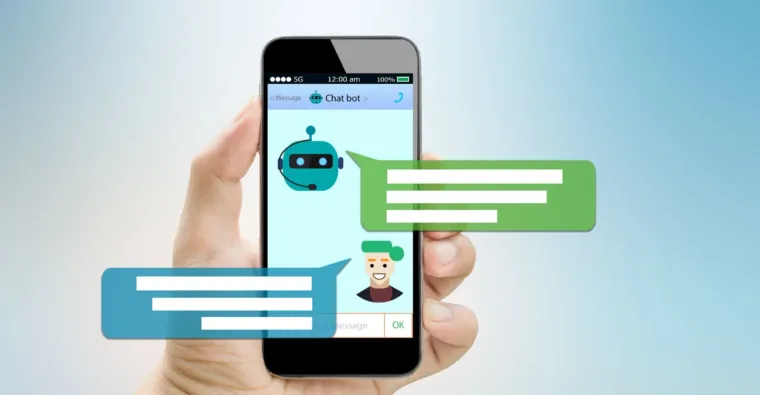In the fast-paced world of digital marketing, businesses are constantly seeking innovative ways to engage with their audience, streamline processes, and deliver exceptional customer experiences. Among the array of technological advancements, chatbots have emerged as powerful tools that facilitate communication and revolutionize how brands interact with their customers. From automating responses to providing personalized recommendations, chatbots are reshaping the landscape of digital marketing and enhancing customer interaction and experience profoundly.
Artificial intelligence software like chatbots is programmed to simulate human conversation. They use natural language processing technology to understand and interpret user input and generate responses based on predetermined rules or machine learning algorithms. Chatbots are commonly used in the sales and customer service sectors. Customers appreciate the convenience of chatbots’ immediate responses and the ability to provide necessary information quickly without human involvement. Chatbots help businesses handle numerous customer inquiries and reduce the need for additional staff. They can also be utilized for internal purposes like addressing employee questions and assisting with various tasks.
The Rise of Chatbots
Chatbots, powered by artificial intelligence (AI) and natural language processing (NLP) technologies, have become integral components of digital marketing strategies across industries. These intelligent virtual assistants are designed to simulate human conversation and assist users in various tasks, ranging from answering queries to processing orders.
The proliferation of messaging platforms and the growing preference for instant communication have contributed to the widespread adoption of chatbots. Whether it’s Facebook Messenger, WhatsApp, or website live chats, consumers now expect quick and convenient access to information and support, making chatbots indispensable for businesses looking to stay competitive in today’s market.
What are Chatbots, and How do customer service chatbots work?
Today’s digital marketing significantly differs from traditional marketing practices of the past. In the digital age, marketing strategies are driven by data, automation, and intelligence. Technologies such as big data analytics, artificial intelligence (AI), advancements in data storage, faster microprocessors, and other developments in information technology are reshaping marketing processes. These technologies enable businesses to create new solutions that revolutionize customer interactions, shifting the focus from human-oriented to technology-oriented interfaces.
One key technology transforming customer experiences and service processes is artificial intelligence-based chatbots. These chatbots, also known as talkbots, chatterbots, or digital assistants, are computer programs designed to simulate human conversation and provide virtual assistance to online customers. Various industries, including human resources, education, tourism, healthcare, banking, and more, benefit from chatbots’ capabilities.
Customer service chatbots work through natural language processing (NLP), machine learning algorithms, and predefined rules and scripts. Here’s how they generally function:
Natural Language Processing (NLP):
NLP allows chatbots to understand and interpret human language input. When a user types a message or speaks to the chatbot, NLP algorithms analyze the text or speech to identify the user’s intent and extract relevant information.
Intent Recognition:
Chatbots use intent recognition algorithms to determine what the user tries to accomplish based on their input. For example, if a user asks about product pricing, the chatbot recognizes the intent as “pricing inquiry.”
Entity Extraction:
Along with identifying the intent, chatbots extract key information from the user’s input, such as product names, order numbers, or specific issues. This helps the chatbot provide more relevant and personalized responses.
Machine Learning (ML):
Many modern chatbots leverage machine learning algorithms to improve their performance continuously. They analyze past interactions and user feedback to refine their understanding of language patterns, intents, and user preferences over time.
Predefined Rules and Scripts:
Chatbots often operate based on predefined rules and scripts that developers or customer service teams provide. These rules help the chatbot respond appropriately to common queries and situations. For instance, if a user asks for a refund, the chatbot follows a predefined process for handling refund requests.
Integration with Backend Systems:
Chatbots are often integrated with backend systems such as customer databases, inventory management systems, and knowledge bases in customer service contexts. This integration allows chatbots to access relevant information and perform actions like checking order status, updating customer profiles, or providing troubleshooting guidance.
Escalation to Human Agents:
While chatbots can handle many customer inquiries autonomously, they are also programmed to recognize when a query requires human intervention. In such cases, the chatbot can escalate the conversation to a human customer service agent with the expertise to resolve the issue.
Overall, customer service chatbots aim to provide efficient and personalized support to users by understanding their queries, providing relevant information or assistance, and seamlessly integrating with existing customer service workflows.
DIFFERENT TYPES OF CHATBOTS
Chatbots come in various types depending on their functionality and design. Some common types include rule-based chatbots, AI-powered chatbots, virtual assistants, and social media chatbots. Each type has features and capabilities that cater to different user needs and requirements.
In today’s business environment, your company must choose the right chatbot to improve efficiency and streamline business processes. To select the best chatbot, it is necessary to properly categorize them and evaluate the advantages and disadvantages of each category. There are different types of chatbots based on their capabilities and functionalities:
Rule-based chatbots: These are programmed with rules and predefined responses to specific keywords or phrases. They follow a decision tree to guide the conversation with users.
AI-powered chatbots: Use artificial intelligence and machine learning algorithms to naturally understand and respond to user queries. They can learn from interactions and improve their responses over time.
Virtual assistants: These chatbots are designed to assist users with tasks and provide personalized recommendations. They can perform various functions, such as scheduling appointments, answering questions, and providing information.
Transactional chatbots: These chatbots are integrated with e-commerce platforms and are designed to help users with transactions, such as making purchases, tracking orders, and providing customer support.
Social media chatbots: These are integrated with social media platforms to engage with users, provide customer support, and offer personalized recommendations based on user preferences and behavior.
Chatbots come in various forms and serve different purposes, depending on the needs of businesses and users.on consumer behavior, ethical challenges posed by chatbots, and the future of chatbots in marketing.
Boosting Customer Engagement through Chatbots
Chatbots are unique automated tools that engage customers in interactive conversations, provide proactive support, and create stronger connections between customers and brands. They achieve this by offering personalized interactions, responding instantly to inquiries, providing round-the-clock support, analyzing customer data for insights, and automating repetitive tasks. This results in improved customer satisfaction, loyalty, and business cost savings. By providing customized and interactive conversations, chatbots can:
- Engage customers in a more significant and memorable manner.
- Provide immediate answers to customer queries.
- Offer support around the clock.
- Gather and analyze customer information for improved understanding.
- Automate repetitive tasks, freeing up human agents for more complex issues
Additionally, chatbots can enhance the customer experience through proactive support, anticipating customer needs, and offering timely assistance. This proactive approach boosts customer satisfaction and strengthens the relationship between the brand and the customer, leading to long-term loyalty and increased advocacy for the brand.
One of the primary benefits of chatbots in digital marketing is their ability to enhance customer interaction at every touchpoint of the buyer’s journey. Unlike traditional forms of communication, such as emails or phone calls, chatbots offer real-time engagement, allowing brands to establish immediate connections with their audience. In addition to facilitating seamless communication, chatbots are crucial in improving the overall customer experience by simplifying processes and removing friction points throughout the customer journey.
24/7 Availability: Chatbots operate round the clock, providing customers instant assistance regardless of time zones or business hours. This accessibility ensures that users can obtain information and support whenever needed, leading to higher satisfaction and loyalty. With chatbots, customers no longer have to navigate through lengthy menus or wait in queues to connect with a representative. Chatbots eliminate frustration and enhance convenience by offering immediate assistance and self-service options, leading to higher satisfaction and loyalty.
Personalized Conversations: Through advanced algorithms and data analytics, chatbots can analyze user preferences, behavior patterns, and purchase history to deliver personalized recommendations and content. By tailoring interactions based on individual interests and needs, chatbots create more meaningful and relevant customer experiences, driving engagement and conversion rates.
Efficient Problem Resolution: Chatbots excel at handling routine inquiries and troubleshooting common issues, freeing up human agents to focus on more complex tasks and strategic initiatives. Chatbots help businesses streamline operations, reduce response times, and ensure consistent service quality across channels by automating repetitive tasks.
Interactive Engagement: Interactive features such as quizzes, surveys, and product recommendations enable brands to engage customers in meaningful conversations and gather valuable insights into their preferences and purchase intent. By leveraging interactive elements, chatbots transform passive interactions into dynamic experiences that resonate with users and drive conversion.
Seamless Integration: Chatbots seamlessly integrate with existing digital marketing channels and platforms, including websites, social media, and mobile apps, providing a unified and cohesive experience across touchpoints. By consolidating communication channels and centralizing customer data, chatbots enable businesses to deliver personalized and consistent messaging at every stage of the customer lifecycle.
The Future of Chatbots in Digital Marketing
As technology and consumer expectations evolve, chatbots will continue to play a pivotal role in shaping the future of digital marketing. With advancements in AI, machine learning, and natural language understanding, chatbots will become increasingly sophisticated, capable of delivering hyper-personalized experiences and predictive insights that drive customer engagement and loyalty.
Furthermore, integrating chatbots with emerging technologies such as augmented reality (AR), virtual reality (VR), and voice assistants will open up new possibilities for immersive and interactive brand experiences, allowing businesses to connect with customers more meaningfully and innovatively.
As businesses continue to embrace the transformative potential of chatbots, it’s clear that their role will only grow in significance, shaping the future of marketing and redefining the way brands connect with customers in the digital age.
In conclusion, chatbots represent a powerful tool for enhancing customer interaction and experience in digital marketing. By providing seamless communication, personalized engagement, and streamlined processes, chatbots enable brands to build stronger relationships with their audience, drive business growth, and stay ahead in an increasingly competitive landscape.








